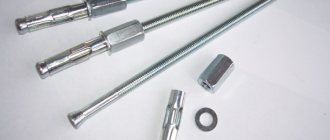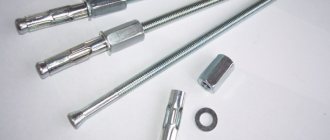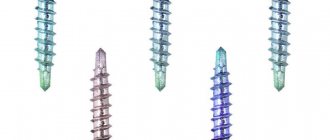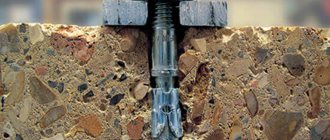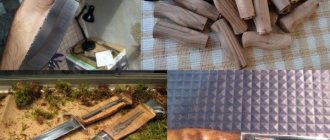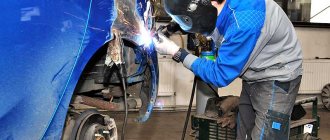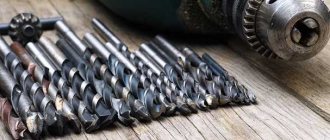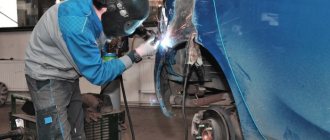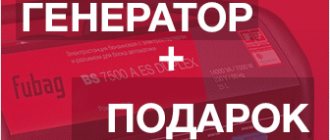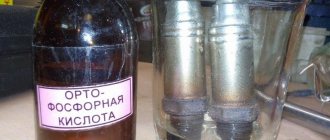When building a house or renovating an apartment, there is often a need to secure some heavy objects, be it a water heater for the bathroom, a wall unit for a child's room, or a china cabinet. And at the same time, a margin of safety is required.
Ordinary dowels with plastic spacers cannot always help in this matter; “heavy artillery” is needed here - these are anchors.
An anchor (“anchor” in German) is a bolt with a thread and a nut; the kit also includes a spacer part; such fasteners are designed for attaching weighty structures. From the photographs you can understand the features of the anchors, as well as their scope of application.
The history of the development of this fastener dates back to 1973, when a German council of experts began working on the calculation of permissible anchor fastenings. And in 1998, the regulation on the use of metal anchors in concrete ETAG 001 was issued.
In addition to solving household repair issues, anchor bolts are used in the construction industry; therefore, there are many types of anchors, from simple ones - created for fixed structures, to specific ones - solving issues of constant pressure and bending on the fastening element.
Advantages and disadvantages of anchor connections
Disadvantages include:
- Expensive cost;
- A lot of installation tools are required (puncher, hammer, screwdriver, wrench);
Advantages:
- Increased safety margin;
- Copes with pull-out loads;
- Long service life;
- Increased level of security.
An important characteristic of anchors is the material of manufacture. Only high-quality structural steel is used to make anchors or durable aluminum-based alloys.
The material used to make anchors must withstand loads and deformations. In addition, resistance to corrosion is an important quality, because anchor connections last for decades, so brass, aluminum and stainless steel are used, which do not rust.
When installing anchors in wet rooms, you should choose them with a thicker galvanized layer.
Wedge - for high loads
This is the most common category of anchor bolts, widely used in private and capital construction. In appearance, it is a metal rod, wedged on one side and threaded on the other. There is a spacer sleeve on the conical part; the basic package includes a nut and washer.
Wedge anchors are used for mounting loaded structures on concrete surfaces.
This could be the arrangement of elevator shafts, staircases, installation of utilities. In domestic conditions, such anchor bolts are used for ceiling mounting of large and heavy chandeliers.
| Advantages | Flaws |
|
|
Also, the disadvantages include “non-removability”: the installed anchor cannot be dismantled and reused.
In the table you will find designations and descriptions of anchors from well-known manufacturers.
| Manufacturer | Type | Manufactured diameters and lengths of anchors, (mm) | Examples and explanations of designations (dimensions are indicated in mm) | Peculiarities |
| Fischer (Germany) | FBN | 6…20 (40…421) | FBN 12/100[+120] [GS] 12 – diameter of anchor and thread; 100 – useful length t – standard; 120 – maximum length t (not always specified); GS – equipped with a wide washer DIN 9021 (not specified with a regular washer DIN 125 ). FAZ 12/10[GS] FAN 10/100 FB 16/25 A4 | Fischer Bolzen. Steel 6.8 galvanized or A4 stainless. The most common due to its low cost and high reliability. |
| FB | 6…16 (65…173) | Limited production (mainly from A4 ) | ||
| FAZ | 8…24 (75…234) | Fischer Ankerbolzen Patented special expansion sleeve design allows applications in stretched and fractured areas of concrete | ||
| FAN | 10…12 (90…193) | Limited edition (made of A4 ) | ||
| Hilti (Liechtenstein) | HST | 8…12 (75…235) | HSA-F M16x190/75[/95] 16 – diameter of anchor and thread; 190 – full length of the anchor; 75 – useful length t – standard; 95 – maximum length t (not always specified); HST M12x115/20 | Hilti Stud Anchor. Steel of strength class 6.8 galvanized (5 microns). A4 stainless steel . |
| HSA | 6…20 (50…300) | |||
| Mungo (Switzerland) | MSD | 6…20 (50…270) | m3 12x113 12 – diameter of anchor and thread; 113 – full length of the anchor. MSD 10x120 MSD-C 16×300 – with wide washer DIN 9021 MSDr 10×70 – A2 stainless steel | Stahlbolzen.. Galvanized steel |
| m3 | 6…20 (50…170) | The special design of the spacer sleeve ensures high reliability against rotation of the anchor and maintains load-bearing capacity in cracked concrete. | ||
| Sormat (Finland) | S-KA | 6…20 (40…280) | S-KA 8×50 8 – diameter of anchor and thread; 50 – full length of the anchor. S-KAK D 12/65 12 – diameter of anchor and thread; 65 – useful length t; D – anchor with two spacers | Kiila-ankkuri Made from steel 6.8 according to DIN 1654 or 1651 , electro-galvanized. |
| S-KAK | 6…20 (40…280) | Same as S-KA anchors, but hot-dip galvanized. | ||
| S-KAH | 6…20 (40…220) | The same, but made of stainless acid-resistant steel A4 . | ||
| Tox (Germany) | B.A. | 6…16 (65…315) | BA 12/30/125 12 – diameter of anchor and thread; 30 – useful length; 125 – full length of the anchor. | Bolzenanker galvanized steel |
| Allfa (Germany) | 72000 | 6…12 (40…180) | 72000-10150 10 – diameter of anchor and thread; 150 – full length of the anchor. | Wedge anchor. Galvanized steel yellow passivated. |
| NOBEX (Italy) | TM TMX TMXX | 6…20 (40…220) | TM 8×115 8 – diameter of anchor and thread; 115 – full length of the anchor. | Ancoranti TM – galvanized steel, TMX – stainless steel A2 , TMXX – stainless steel A4 |
| Koelner (Poland) | S.R. | 6…20 (40…250) | SR-12×130 10 – diameter of anchor and thread; 130 – full length of the anchor. | Wedge anchor. Steel 4.6 galvanized, yellow passivated. |
| Technox (Poland) | BZ | 6…16 (75…300) | BZ 10/130 [A4] 10 – diameter of anchor and thread; 130 – full length of the anchor | Kotwa stalowa Galvanized steel (stainless bushing) or all stainless steel A4 |
| B | 6…20 (40…350) | B 16/115 16 – diameter of anchor and thread; 115 – full length of the anchor | Steel A45 galvanized | |
| B.L. | 8…16 (75…175) | |||
| Anchor Fasteners (Taiwan) | WAM | 6…20 (40…300) | WAM-10125 10 – diameter of anchor and thread; 125 – full length of the anchor. | Wedge anchor . Galvanized steel, yellow passivated. |
| INKA (Türkiye) | IDKL | 6…16 (75…145) | IDKL12110 12 – diameter of anchor and thread; 110 – full length of the anchor. | Klipsli Dubel Steel 5.6 galvanized |
Expansion anchors
Expansion anchors are more often used for fastening heavy structures (metal doors). These are metal cylindrical bushings with grooves on the body. When the nut is tightened with a wrench, the bushing expands over the entire surface and rests closely against the base material.
The advantage of these anchors is their ability to withstand heavy loads in the perpendicular and longitudinal directions.
Working principle and application
Concrete is a porous material with a heterogeneous structure. And in the places of fastening, various forces appear - twisting, bending, shearing, shearing, compression, tearing. The concrete anchor takes over them, distributing them together with the supporting structure.
Basic principles of operation of concrete anchors:
Anchors for concrete can be of different designs, types, sizes. They are made from special steel according to GOST and coated with a layer of anti-corrosion agent. The rod can be 6-20 millimeters in diameter and up to 220 millimeters long.
Kawabanga! Characteristics of epoxy impregnation for concrete
Any anchor includes the following parts:
- The bolt itself
- Cone with a layer of thread inside
- Bushing with special cutouts
Structural fasteners are used to counteract the displacement of parts of the assembly if their stability is guaranteed by their own weight; anchors are also relevant when straightening in construction.
Fasteners for hollow materials
Double-expansion anchors are metal products consisting of steel bushings mounted on a stud. When tightening the nut on the outside, the bushings located inside diverge, the sleeve is deformed over the entire surface, because The bushings diverge in different spacer zones, which ensures reliable fixation in the wall; anchors of this type are almost impossible to remove after installation.
“Butterfly” anchors with an expansion mechanism are suitable for lightweight structures; they are used to fasten interior parts (pictures, sconces, shelves) to flat materials no thinner than 10 mm (plasterboard, chipboard, plywood).
The “wings” of the anchor open and are tightly fixed on the back side of the material. The reliability of the assembly depends on the base into which the anchor is screwed.
When choosing anchor products, it is necessary to take into account: the characteristics of the material of both the anchor and the base surface, the weight of the fixed equipment, installation principles and, of course, stock up on the necessary tools.
Areas where anchor bolts are used
Depending on the design features, parameters of rigidity and strength, and pull-out indicator, anchor bolts have the following areas of application:
- for securing parts of buildings - balconies, loggias, flights of stairs, railings and consoles;
- for installation to foundations, bricks, rubble of various structural elements - guy wires for masts, cables, signs, etc.;
- for installation of suspended split systems, beam mechanisms.
There are anchor bolts of mechanical and chemical operating principles. Bolts with a mechanical principle of action are available with hex heads, with a countersunk head, with a hook, with a ring, as well as with an impact thrust and in the form of a stud.
Anchor bolts with a chemical operating principle are used in the most critical areas, since their adhesive strength is significantly superior to mechanical ones.
The significant advantages of this type of anchor bolts are:
- possibility of application for external and internal work;
- insensitivity to surface vibrations;
- Possibility of use on low-strength bases such as shell rock and aerated concrete.
Video description
From the video you can find out how the anchor behaves in a load-bearing foundation:
Expanding
This concrete anchor is a petal sleeve with a built-in nut at the end. As a result of screwing in the bolt, the entire body expands, except for the edges. This explains the applicability of the products for working with porous and hollow substrates.
Such fasteners can be dismantled and reused if desired. For through immersion of the pin, the hole for the “anchor” is drilled to a depth with a margin of 20 mm. For the calculation, the length of the sleeve is taken.
Expansion fastener Source www.obudom.com
Frame
These anchors are designed for mounting window frames and door frames. The operating principle of the “anchor” is based on expansion-type hardware. Only the petals are shifted to the lower part of the body. And on the top there are molded stops that prevent rotation and displacement of the sleeve.
Chemical
Such anchors are represented by bolts or studs, which are immersed in a liquid, quickly hardening mass with adhesive properties. As a result, the load on the hardware is distributed evenly along the entire length. This makes it possible to install fasteners in any base: dense, porous, fibrous or hollow.
The working mass of a chemical anchor is a two-component resin of synthetic origin (the second substance is intended to accelerate the hardening of the composition). The advantages of fasteners include the following:
- high connection strength;
- the possibility of eliminating toxic substances from the composition;
- no odor;
- dry residue hardness without thermal expansion;
- applicability for almost any substrate outdoors and indoors;
- hermetic filling of voids in the seat;
- maintaining technical characteristics for more than 50 years.
Dowel made of hardened resin Source kayrosblog.ru
Briefly about the main thing
The concrete anchor bolt is designed for fixing heavy structures and equipment.
Mechanical anchors vary in structure. They can be driven, spacer, wedge, sliding and frame. They are used to work with dense or porous substrates.
Chemical anchors are available as ampoule or injection. The first ones have a glass dowel and a small amount of liquid mass. Suitable for monolithic concrete. The latter are relevant for any base, since the resinous adhesive substance fills almost the entire space of the seat until it begins to harden.
The marking will allow you to decide on the choice of anchors based on size, and the accompanying documentation based on load-bearing capacity.
Anchor nail
Simple threadless anchor. Similar to hammers (Fig. 11). The bushing has longitudinal cuts (1) at one end, and a low semicircular flange (2) and a wedging nail (3) at the other. The bushing is installed all the way into the base with the flange facing outwards (Fig. 12). When driving a nail, the split part of the sleeve opens and fastening occurs by friction.
Rice. eleven
Rice. 12
Types of anchors by installation method
Ampoule - is a glass capsule with a two-component mixture and is intended for one-time use. Requires mixing directly in the hole.
Cartridge - the adhesive composition is located in a cylinder and is mixed immediately upon feeding. A special gun is required to insert into the hole.
Some manufacturers produce tubes with a measuring scale, which greatly simplifies the feeding process and eliminates the need for additional tools during installation.
An adjustable anchor is installed under the posts and is able to adjust the horizontal surface relative to the vertical.
Kawabanga! Rules for using polyurethane foam
